Exceeding the torque application value can compromise the success of the treatment, regardless of the quality of the materials and products used or how revolutionary our technique is.
A high insertion torque is associated with the possible appearance of over compression and bone necrosis, which could lead to loss of fixation of the implant to the bone.
Applying high torque in search of primary stability is a double-edged sword: although we believe that we are achieving greater fixation of the implant to the patient’s bone, what we are really doing is compromising secondary stability, and therefore the long-term survival of the implant.
High torques can lead to distortions in the implant connection, resulting in the formation of microcracks and microgaps and, consequently, cause the attachment to not fit properly, increasing the effects caused by fatigue.[1]
There is a wealth of literature on the importance of applying the correct torque value during dental implant placement, and the influence between connection types.
Torque in conical connection implants
By analysing an infinite number of elements and simulating the distribution of forces in an implant-abutment system, several authors have compared the stresses caused by various loads in implants with different connections, with the aim of observing which areas of this system are more critical depending on the type of connection.
In the following image, we can see the force distribution in the different connections:
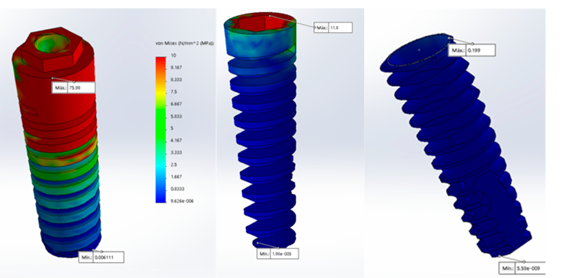
While the external and internal hexagonal connections concentrate all the forces in the neck area, we see that the conical connection distributes them equally along the entire body.
This is because the conical connection makes a kind of weld between the implant and the abutment, making both behave as if they were a single piece and thus achieving an optimal distribution of forces and a reduction of microgaps and micromovement.
The reliability of the conical connection is higher than any other due to the increased strength of the structure, which reduces the loosening of the implant-abutment assembly and, at the same time, reduces the microgap between them, eliminating bone resorption at the external level [5].
In the abutments, we can see how the loads are concentrated on the surface in contact with the implant and, especially, on the edges and abrupt changes in the section of internal polygonal connections. These areas are the most critical because this is where there is the highest concentration of stresses and also where the implant has the smallest section (neck). It is therefore necessary to treat these areas with care, especially in the case of small diameter implants.
It is well known that, during fatigue stresses, sharp angles, pronounced apexes and the presence of cracks induce stress concentration through which defects will be propagated leading to failure of the parts.[4]
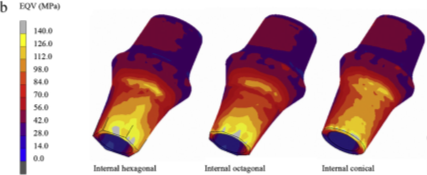
Therefore, we can determine that in case of excessive loads on the conical connection, these loads are directed towards the clinical screw, avoiding the induction of defects and micro-cracks in the implant, as the displacement occurs in the abutments. However, it is always advisable to follow the implant manufacturer’s instructions, as this is the only way to ensure correct torque and therefore successful treatment in both the short and long term.
Barone et al. (2016) demonstrated that implants inserted at high torque (≥ 50Ncm) in healed bone crests caused more peri-implantitis and soft tissue recession than when implants were inserted with regular torque (< 50 Ncm)[8].
Since external and internal hexagonal connections tend to divert stresses to the neck area of the implant, exceeding the insertion torque can promote bone resorption, which will result in a change in the distribution of stresses of the implant on the bone. Even in these cases, it has been shown that the most responsive type of connection is still the conical connection. [6], [7]
From this, we can deduce that applying excessive torque can compromise the life of the implants by deforming or inducing defects in the implant connection.[8]
Teixeira et al. (2015) studied three types of connection (internal and external hexagon and conical connection) of a specific brand of implants and showed that, subjected to a torque of 80 and 120 Ncm, they suffered deformation of their components in all three types, with the conical connection implants showing the least deformation [2].
These results are similar to those obtained by Romero et al (2021). In a study with 88 implants of different design and brand differentiated into 11 groups, they demonstrated that 100% of the implants or some of their components suffered a detectable failure when subjected to high torque forces, higher than those indicated by the manufacturer [1].
Gehrke et al. (2021) reported that conical connection implants withstood the highest torque values compared to internal and external hexagonal connection implants when subjected to 4 torque intensities: 60, 80, 100 and 120 Ncm. In all the samples, when applying a torque of 60 and 80 Ncm, only marks were observed on the walls where the screwdriver contacted the implant, without generating major damage. High torque values did generate mechanical damage to the implants studied [10]. Other conclusions were the following:
- Torques above 80 Ncm can cause irreversible deformations that compromise the long-term stability of the implants.
- Torques of 100-120 Ncm caused cracks and deformations in all types of implants evaluated.
- It was observed that excessive torques lead to changes in implant geometry.
- The concentration of stresses generated by excessive torques (higher or equal to 50 Ncm) can lead to bone and gingival resorption, as well as peri-implantitis.
- The conical connection gives a greater mechanical response even after being subjected to loads.
- The connection is where the implant suffers most from torque, a risk area as it is also the one with the smallest thickness.
The main mechanism of implant fracture and failure is caused by cyclic loading (fatigue) from chewing. This fatigue strength is reduced by defects introduced during implant production or handling, which can lead to premature failure after implantation, as shown in the image below. Crack propagation occurs through the areas where the highest stress concentration is generated, in the case of hexagonal internal connections, through the vertices of the hexagon.
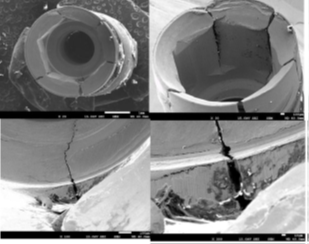
SEM Fractography of explanted Titanium grade 4 implants. Top left image: SEM micrograph of an explanted implant, top view. Top right image: SEM micrograph of a hexagonal internal connection (side view) showing longitudinal fracture cracks; Bottom images: SEM micrographs showing crack propagation at different magnifications. Image obtained and modified from: https://doi.org/10.3390/ma12223728 [11].
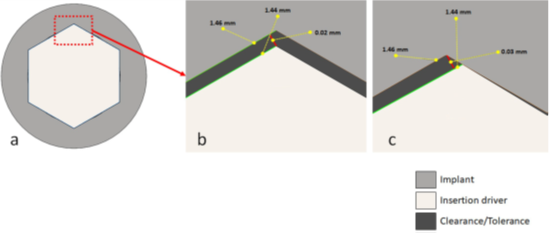
Schematic image of: (a) insertion driver attached to the implant; (b) gap/tolerance between the implant and the insertion driver after coupling; (c) the movement generated after the insertion driver rotation to apply torque. Image obtained and modified from: https://doi.org/10.1371/journal.pone.0251904.g002 [10]
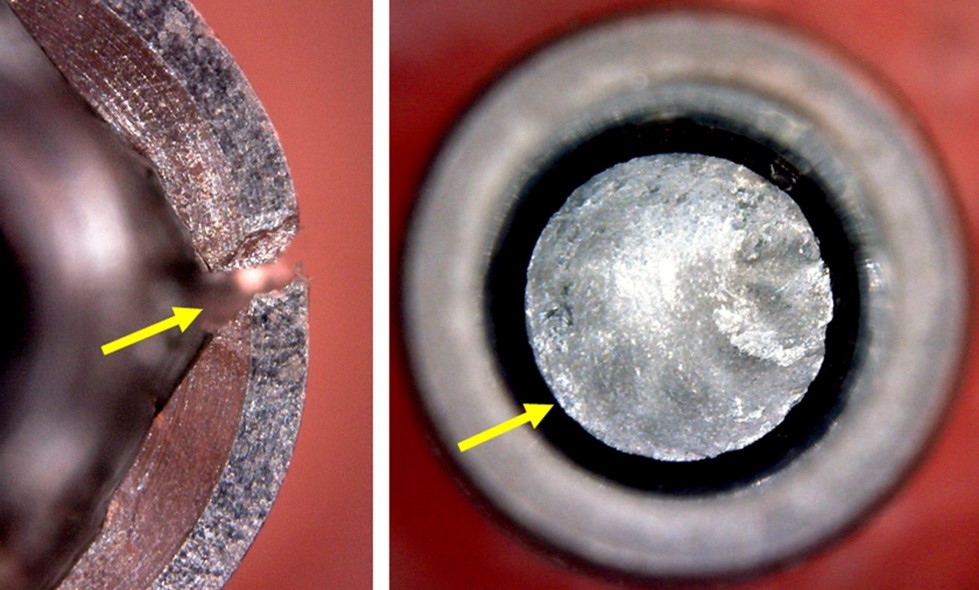
Representative images of the maximum torque applied to the implants: (left) image of an implant sample with hexagonal connection showing a complete fracture of the implant wall (yellow arrow); (right) image of a Morse taper connection sample showing the fracture of the insertion screwdriver inside the implant (yellow arrow). Image obtained and modified from: https://doi.org/10.1371/journal.pone.0251904.g009 [10]
On the other hand, in a non-catastrophic way, the cracks generated in the connections cause microgaps, micromovements and misalignments in the platform heights for any connection design.
Regarding this displacement of abutments, several studies have tested the torque and torque values before and after fatigue processes. In these cases, it has been observed that the conical connection offers greater stability, predictability and a higher success rate caused by this previously mentioned cold welding. However, after cyclic loading, the abutment bolts lost part of their torque value.
Torque measurement methods
It is important to have an accurate method of clinically measuring insertion torque available to the implantologist. The most commonly used are: Surgical torque wrench with electronic and manual operation and torque wrenches with high-torque capacity, electrically controlled units or contra-angle surgical units with torque control, and even industrial dynamometric devices used in experimental animal research [1].
Several in vitro studies for an implant system, with a conical dodecagram connection, concluded that the displacement of the axial abutment increases continuously with the amount of torque applied to the retaining screw. Because of this variation, it was concluded that the proximal contacts and occlusal/incisal surfaces should be evaluated after applying the manufacturer’s recommended torque. Otherwise, loss of occlusal contacts, changes in the position of the incisal edge and missing or stressed proximal contacts may occur [3].
Torque on internal conical connections such as the Galaxy (H2) implant.
Several studies have evaluated bone loss, prosthetic and biological complications, and survival rates of internal conical connection (ICC) versus non-internal conical connection (INCC) implants [4].
In a study by Rodrigues et al. (2023), there were twelve randomised clinical trials, including 678 patients and 1006 implants (ICC I [n = 476]; INCC [n = 530]). The meta-analysis revealed that ICC demonstrated a lower risk of marginal bone loss (SMD: -0.80 mm; p = 0.004) and prosthetic complications (RR: 0.16; p = 0.01) than INCC.
Conical internal connections, such as our Galaxy implant, maintain preload even better than those with a conical connection.
Ziacom’s Galaxy implant, with conical connection and morphology, is specially designed to ensure maximum predictability and efficiency throughout the surgical process. Galaxy is the perfect ally to ensure optimal torque resistance, as it promotes primary stability and long-term implant survival, as well as prevents micromovement and microleakage responsible for possible bone loss due to the application of loads.
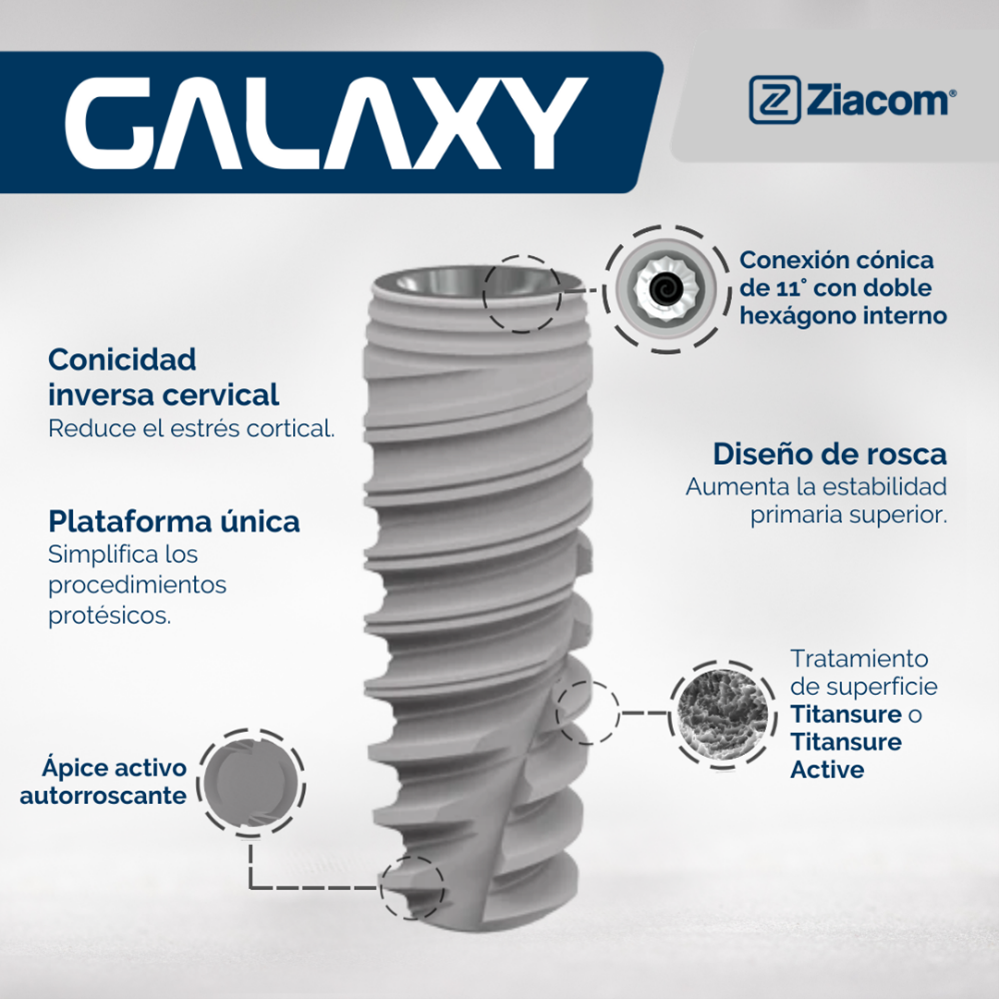
The role of component material in torque resistance
It is essential that the material of which the retaining screw is made has properties which, in addition to providing adequate fracture toughness, promote the maintenance of preload and withstand the forces generated by the screw. Most retaining screws are made of titanium and its alloys [8].
In line with this, Taborda et al. (2021) evaluated the influence of different metal alloys on the level of torque. For this purpose, they used the universal cast to long abutment (UCLA) made of 4 titanium alloys (Ti cp grade 2, Ti cp grade 4, Ti cp grade 4 hard, and Ti grade 5 Ti6Al4V) and surgical steel for external hex and conical connection implants, subjected to fatigue [14].
Some of their most interesting conclusions were the following:
- Surgical steel for the conical connection positively influenced the untwist value.
- For the conical connection, the best performing alloy was steel.
- The fatigue process had a negative influence on the maintenance of the preload for this connection.
- The alloy with the lowest strength was Ti grade 2 [14].
The torque value and its relation to bacterial microleakage in conical connection implants
While the external connection is designed for ease of insertion at surgery, internal connection implants are considered much more convenient for immediate stability. The conical connection, on the other hand, performs better [15].
Regardless of the type of connection, the fit between implant and abutment should favour load distribution and biological response, as well as hinder bacterial growth. [3], [7], [16].
This bacterial proliferation is caused by microgaps which, due to micro-movements, allow microorganisms and their fluids to pass through [15]. This is where the torque value plays a very important role: with an adequate torque we contribute to the stability of the abutments and, therefore, it will be decisive in preventing the formation of microgaps and their bacterial infiltration.
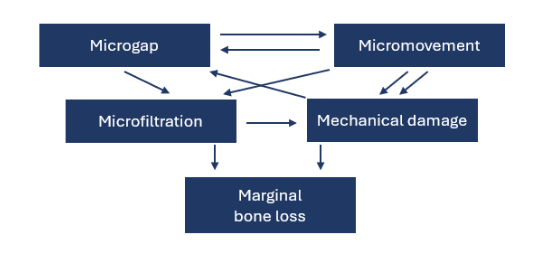
A recently published study demonstrated that conical connection implants have better abutment-to-implant stability when subjected to different loading values [15]. In addition, several in vitro studies have shown that, in most implant systems with a conical connection, the microgap that initially exists after insertion and the torque of the abutments in the implant is reduced with the application of loads [15].
Conclusions and tips for applying an appropriate torque value
- It is essential to have an accurate method of clinically measuring the insertion torque available to the implantologist.
- Knowing the minimum torque value that must be respected according to each implant design/connection type is relevant from a clinical point of view in order to avoid mechanical complications.
- The literature agrees that high torque values would threaten and put the implant platform at risk.
- It is important to understand the mechanical characteristics of the materials and the biomechanics of preloading. It is also essential to determine the importance of variables that may interfere with this process before applying any external load to achieve a stable abutment-implant connection.
- The appropriate torque value can play an important role in the formation of microgaps and bacterial infiltration, being one of the main factors in determining the stability of abutments.
- The connection that generally performs best is the conical connection.
BIBLIOGRAPHICAL REFERENCES:
[1] T. Villa Romero et al., «Resistencia de diferentes implantes y componentes sometidos a sobre torque. Estudio in-vitro», Revista de la Asociación Odontológica Argentina, vol. 109, n.o 3, pp. 149-157, dic. 2021, doi: 10.52979/raoa.1148.
[2] R. Angeles Maslucan y J. A. Dominguez, «A Finite Element Stress Analysis of a Concical Triangular Connection in Implants: A New Proposal», Materials (Basel), vol. 15, n.o 10, p. 3680, may 2022, doi: 10.3390/ma15103680.
[3] N. Jacobs, R. Seghi, W. M. Johnston, y B. Yilmaz, «Displacement and performance of abutments in narrow-diameter implants with different internal connections», The Journal of Prosthetic Dentistry, vol. 127, n.o 1, pp. 100-106, ene. 2022, doi: 10.1016/j.prosdent.2020.11.008.
[4] M. Souiyah, A. Muchtar, A. Alshoaibi, y A. K. Ariffin, «Finite Element Analysis of the Crack Propagation for Solid Materials», American Journal of Applied Sciences, vol. 6, n.o 7, pp. 1396-1402, jul. 2009, doi: 10.3844/ajassp.2009.1396.1402.
[5] S. Saidin, M. R. Abdul Kadir, E. Sulaiman, y N. H. Abu Kasim, «Effects of different implant–abutment connections on micromotion and stress distribution: Prediction of microgap formation», Journal of Dentistry, vol. 40, n.o 6, pp. 467-474, jun. 2012, doi: 10.1016/j.jdent.2012.02.009.
[6] M. Prados-Privado, S. A. Gehrke, R. Rojo, y J. C. Prados-Frutos, «Probability of Failure of Internal Hexagon and Morse Taper Implants with Different Bone Levels: A Mechanical Test and Probabilistic Fatigue», Int J Oral Maxillofac Implants, vol. 33, n.o 6, pp. 1266-1273, 2018, doi: 10.11607/jomi.6426.
[7] S. A. Gehrke, M. Souza Dos Santos Vianna, y B. A. Dedavid, «Influence of bone insertion level of the implant on the fracture strength of different connection designs: an in vitro study», Clin Oral Investig, vol. 18, n.o 3, pp. 715-720, abr. 2014, doi: 10.1007/s00784-013-1039-7.
[8] A. Barone et al., «The Effect of Insertion Torque on the Clinical Outcome of Single Implants: A Randomized Clinical Trial», Clin Implant Dent Relat Res, vol. 18, n.o 3, pp. 588-600, jun. 2016, doi: 10.1111/cid.12337.
[9] A. B. V. Teixeira, A. C. Shimano, A. P. Macedo, M. L. C. Valente, y A. C. dos Reis, «Influence of torsional strength on different types of dental implant platforms», Implant Dent, vol. 24, n.o 3, pp. 281-286, jun. 2015, doi: 10.1097/ID.0000000000000247.
[10] S. A. Gehrke, G. M. A. Pereira, A. F. Gehrke, N. D. B. Junior, y B. A. Dedavid, «Effects of insertion torque on the structure of dental implants with different connections: Experimental pilot study in vitro», PLOS ONE, vol. 16, n.o 5, p. e0251904, may 2021, doi: 10.1371/journal.pone.0251904.
[11] E. Velasco-Ortega, A. Flichy-Fernández, M. Punset, A. Jiménez-Guerra, J. M. Manero, y J. Gil, «Fracture and Fatigue of Titanium Narrow Dental Implants: New Trends in Order to Improve the Mechanical Response», Materials (Basel), vol. 12, n.o 22, p. 3728, nov. 2019, doi: 10.3390/ma12223728.
[12] B. Yilmaz, S. Hashemzadeh, J. D. Seidt, y N. L. Clelland, «Displacement comparison of CAD–CAM titanium and zirconia abutments to implants with different conical connections», Journal of Prosthodontic Research, vol. 62, n.o 2, pp. 200-203, abr. 2018, doi: 10.1016/j.jpor.2017.08.009.
[13] V. V. M. Rodrigues et al., «Is the clinical performance of internal conical connection better than internal non-conical connection for implant-supported restorations? A systematic review with meta-analysis of randomized controlled trials», J Prosthodont, vol. 32, n.o 5, pp. 382-391, jun. 2023, doi: 10.1111/jopr.13655.
[14] M. B. Bello Taborda, G. S. Yaguinuma Gonçalves, C. Alves de Sousa, y W. Gonçalves Assunção, «Analysis of Torque Maintenance and Fracture Resistance after Fatigue in Retention Screws Made of Different Metals for Screw-Retained Implant-Borne Prosthesis Joints», Int J Dent, vol. 2021, p. 9693239, nov. 2021, doi: 10.1155/2021/9693239.
[15] S. A. Gehrke, G. C. Cortellari, P. N. De Aza, J. H. Cavalcanti de Lima, y J. C. Prados Frutos, «Biomechanical evaluation of abutment stability in morse taper implant connections in different times: A retrospective clinical study compared with an in vitro analysis», Heliyon, vol. 9, n.o 4, p. e15312, abr. 2023, doi: 10.1016/j.heliyon.2023.e15312.
[16] O. Camps-Font, A. González-Barnadas, J. Mir-Mari, R. Figueiredo, C. Gay-Escoda, y E. Valmaseda-Castellón, «Fracture resistance after implantoplasty in three implant-abutment connection designs», Med Oral Patol Oral Cir Bucal, vol. 25, n.o 5, pp. e691-e699, sep. 2020, doi: 10.4317/medoral.23700.


